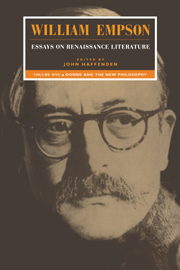Book contents
- Frontmatter
- Contents
- Preface
- Sources and acknowledgements
- Introduction by John Haffenden
- 1 Donne and the rhetorical tradition
- 2 Donne the space man
- 3 Donne in the new edition
- 4 Rescuing Donne
- 5 Donne's foresight
- 6 Copernicanism and the censor
- 7 Thomas Digges his infinite universe
- 8 Godwin's voyage to the moon
- Appendix on Galileo
- Notes
- Index
Appendix on Galileo
Published online by Cambridge University Press: 01 February 2010
- Frontmatter
- Contents
- Preface
- Sources and acknowledgements
- Introduction by John Haffenden
- 1 Donne and the rhetorical tradition
- 2 Donne the space man
- 3 Donne in the new edition
- 4 Rescuing Donne
- 5 Donne's foresight
- 6 Copernicanism and the censor
- 7 Thomas Digges his infinite universe
- 8 Godwin's voyage to the moon
- Appendix on Galileo
- Notes
- Index
Summary
The dialogue form inherently expects a certain amount of evasion, as the author is felt to be rather crude if he identifies himself with one of the characters; but Galileo was a deciding type of man, not to say brash, and it is very unlikely he had no opinion up his sleeve about the first ‘Day’ of the great Dialogue which caused his trial. So much would be agreed, but most people, at any rate in the seventeenth century, felt sure that he believed in life on other stars, and led the reader to the very edge of that forbidden belief without literally expressing it. No doubt he intended people to think so, and did believe in life on other planets in general; but he had found there could not be life on the moon, and this had become an embarrassing secret, which he was determined to hide lest it give comfort to the enemy.
Nearly all of the first ‘Day’ of the Dialogue is occupied with what might seem a minor question – what we would expect to see, looking at the moon, according to the various theories about it. There are three taking part: Salviati who speaks for the author, Sagredo who is intelligent and open-minded, and Simplicio who is an Aristotelian, wrong-headed and foolish. At first Simplicio talks at some length (as the reader must first learn what needs refuting); he says that the moon is a perfect sphere, perfectly smooth, and that its seas would reflect the sun to a distant observer.
- Type
- Chapter
- Information
- William Empson: Essays on Renaissance Literature , pp. 255 - 258Publisher: Cambridge University PressPrint publication year: 1993



